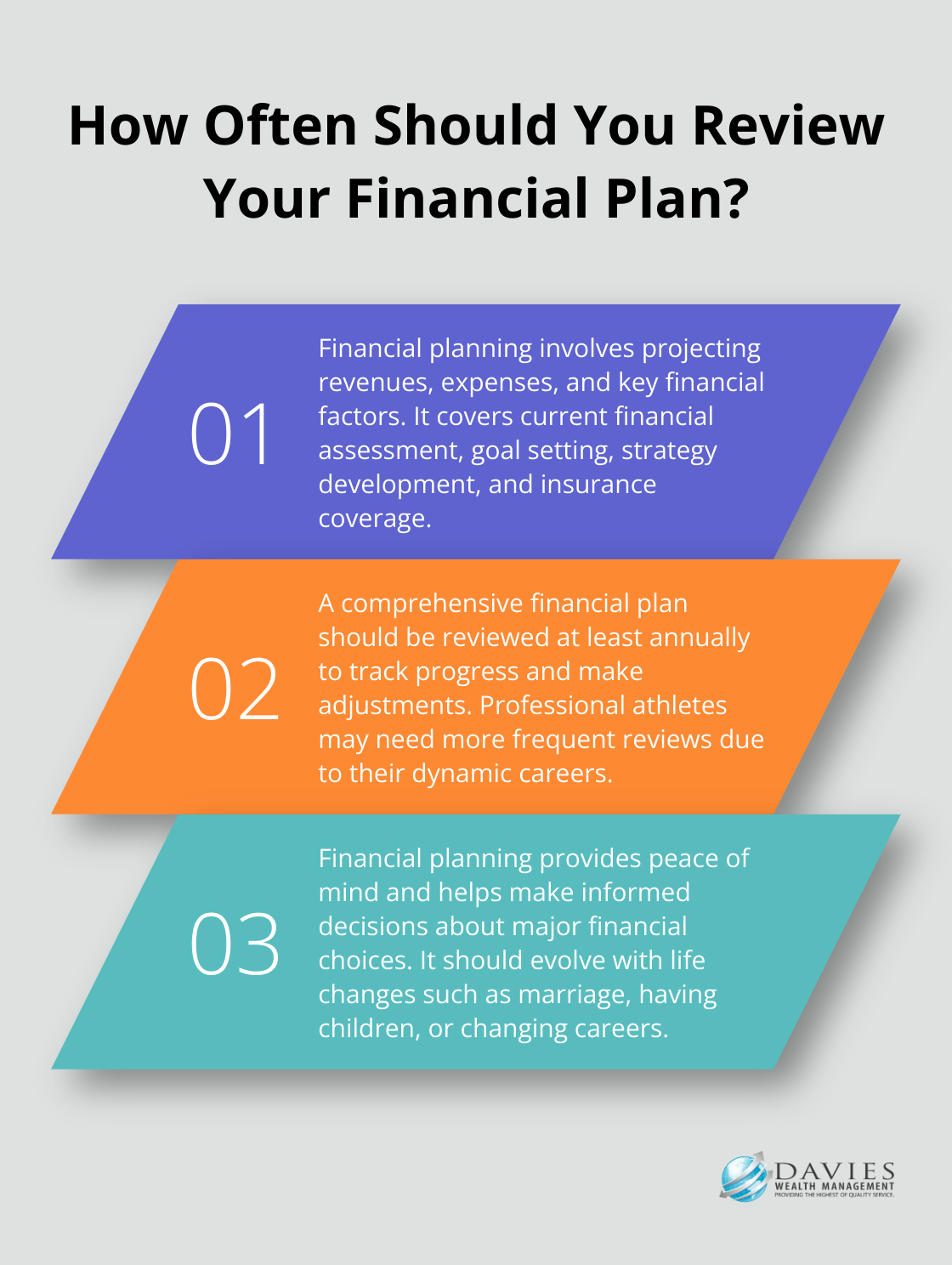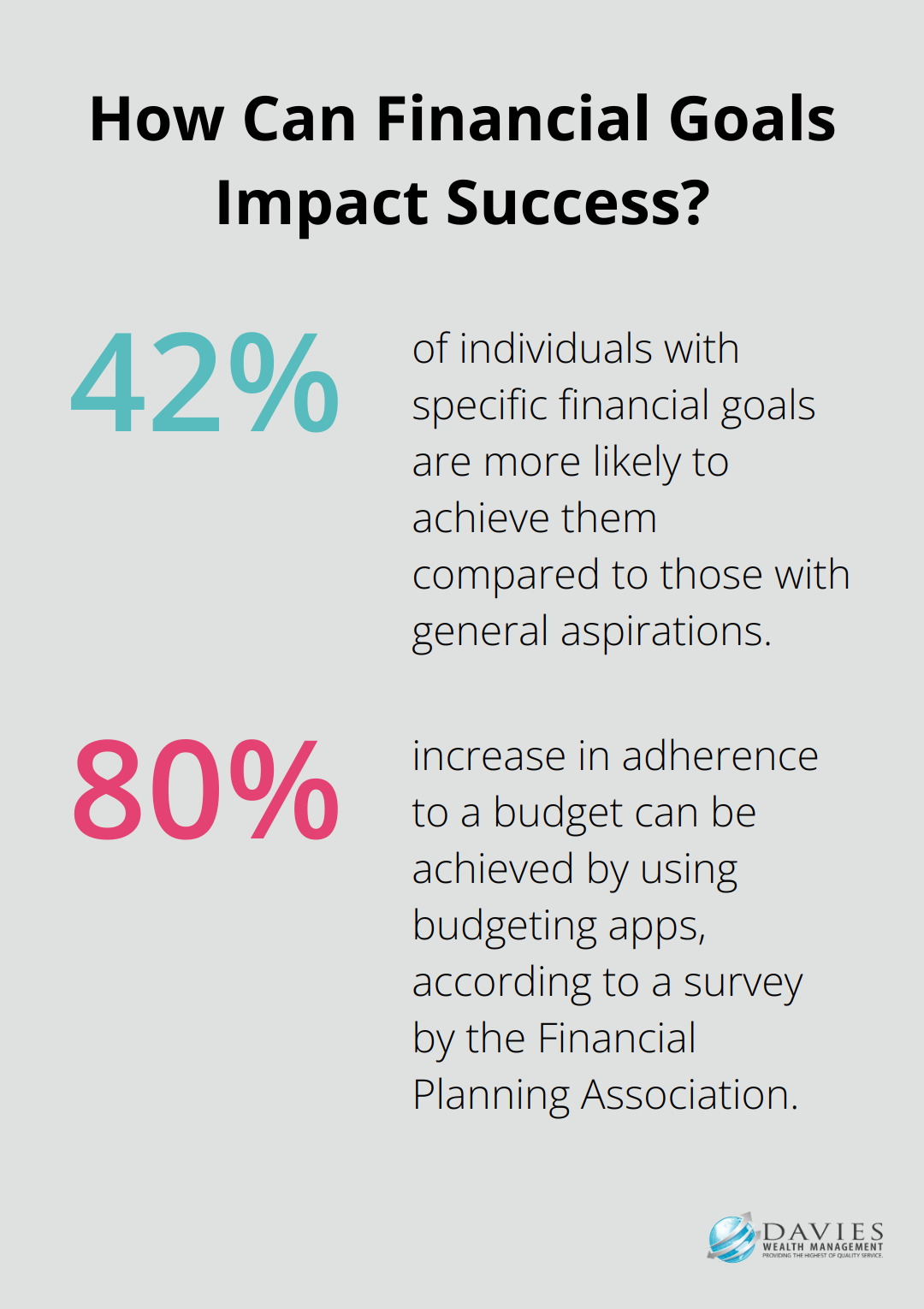Financial planning is the cornerstone of a secure financial future. At Davies Wealth Management, we’ve seen firsthand how a well-crafted financial plan can transform lives and create lasting prosperity.
The benefits of financial planning extend far beyond simple budgeting, encompassing everything from investment strategies to retirement preparation. In this post, we’ll explore how you can maximize these benefits and take control of your financial destiny.
What Is Financial Planning?
The Essence of Financial Planning
Financial planning involves projecting revenues, expenses, and key factors that have a financial impact on the organization. It’s about creating a roadmap for your financial future and taking control of your money to make it work for you. A solid financial plan can transform lives, whether you’re a professional athlete managing a short-term high income or a business owner planning for long-term growth.
The Building Blocks of a Financial Plan
A comprehensive financial plan covers several key areas:
- Current Financial Assessment: This forms the foundation for setting realistic financial goals. It includes an evaluation of your income, expenses, assets, and liabilities.
- Goal Setting: Financial goals might include saving for a home, funding your children’s education, or planning for retirement.
- Strategy Development: This outlines methods for achieving your goals. It often involves creating a budget, developing an investment strategy, and planning for tax efficiency. For example, a mix of stocks and bonds tailored to your risk tolerance and time horizon might be recommended.
- Insurance Coverage: Adequate coverage protects you from unexpected events that could derail your financial progress. This is particularly important for professional athletes, who face unique risks in their careers.
The Impact of Financial Planning
The importance of financial planning is significant. Financial planning provides a foundation for understanding, tracking, and achieving your goals. This peace of mind is invaluable.

Financial planning also helps you make informed decisions. When you understand your overall financial picture, you’re better equipped to weigh the pros and cons of major financial choices. (Should you buy a new car or invest that money? Is now the right time to start a business?) A solid financial plan provides context for these decisions.
The Dynamic Nature of Financial Planning
Your financial plan isn’t a static document. It should evolve as your life changes. Major life events like marriage, having children, or changing careers all impact your financial situation and goals. Maintaining flexibility in your financial strategies allows you to better adapt and respond to challenges.
Financial experts recommend reviewing your financial plan at least annually. This allows you to track progress, make necessary adjustments, and capitalize on new opportunities. (For professional athletes, more frequent reviews may be necessary due to the dynamic nature of their careers.)
As we move forward, let’s explore how to implement effective financial planning strategies that can maximize the benefits of your financial plan.
Turning Financial Goals into Reality
Setting SMART Financial Goals
The first step in effective financial planning requires setting SMART goals – Specific, Measurable, Achievable, Relevant, and Time-bound. Instead of a vague goal like “save more money,” we encourage clients to aim for “save $10,000 for a down payment on a house within 18 months.” This clarity helps maintain focus and motivation.

A study by the Journal of Financial Planning found that individuals with specific financial goals are 42% more likely to achieve them compared to those with general aspirations. This principle proves especially valuable for professional athletes who need to plan for short, intense earning periods.
Creating a Realistic Budget
A well-crafted budget forms the backbone of any successful financial plan. We recommend the 50-30-20 rule as a starting point: 50% of income for needs, 30% for wants, and 20% for savings and debt repayment. However, this approach should be tailored based on individual circumstances.
Many financial advisors suggest using budgeting apps like YNAB (You Need A Budget) or Mint to track expenses. These tools can increase adherence to a budget by up to 80% (according to a survey by the Financial Planning Association).
Diversification: The Key to Investment Success
Diversification plays a critical role in managing risk and maximizing returns. A well-diversified portfolio typically includes a mix of stocks, bonds, real estate, and alternative investments. The exact allocation depends on factors like risk tolerance, time horizon, and financial goals.
For example, a young professional with a high risk tolerance might benefit from a portfolio of 70% stocks and 30% bonds, while someone nearing retirement might prefer a 40% stocks and 60% bonds split. (It’s important to note that these allocations should undergo regular review and adjustment.)
Planning for the Long-Term: Retirement and Beyond
Long-term planning becomes essential, especially when it comes to retirement. Starting early and taking full advantage of compound interest can make a significant difference.
For professional athletes, planning for life after sports takes on added importance. This often involves creating multiple income streams and investing in continued education or business ventures.
Tailoring Strategies to Individual Needs
Financial planning does not follow a one-size-fits-all approach. Each client’s unique circumstances and goals require personalized strategies. This customization ensures that the financial plan aligns with specific needs, whether you’re a professional athlete managing a short career or a business owner planning for long-term growth.
As we move forward, it’s important to recognize that even the best-laid plans can face challenges. In the next section, we’ll explore how to overcome common financial planning hurdles and maintain progress towards your goals.
Navigating Financial Hurdles
Preparing for Unexpected Expenses
Life’s unpredictability demands financial readiness. Setting up a dedicated savings or emergency fund is one essential way to protect yourself, and it’s one of the first steps you can take to start saving. This buffer helps handle unexpected costs without derailing long-term financial plans.

Professional athletes face unique financial challenges due to short career spans and fluctuating incomes. For them, a larger emergency fund (covering 12-18 months of expenses) provides a safety net during off-seasons or in case of career-ending injuries.
Balancing Short-Term Needs and Long-Term Goals
One of the biggest challenges in financial planning is to balance immediate financial pressures with future financial health. The 50/30/20 rule serves as a starting point: allocate 50% of income to needs, 30% to wants, and 20% to savings and debt repayment. However, adjust this ratio based on individual circumstances and goals.
High-income earners like professional athletes often benefit from a more aggressive savings rate. (The average NFL career lasts just 3.3 years.) Given this short earning window, saving 40-50% of income during playing years helps ensure long-term financial stability.
Adjusting to Life Changes
Major life events such as marriage, having children, or changing careers significantly impact financial situations. Regular reviews and adjustments of financial plans reflect these changes.
A comprehensive review of your financial plan should occur at least annually, or more frequently with major life events. This review includes reassessing goals, updating budgets, and adjusting investment strategies if necessary.
Professional athletes benefit from more frequent reviews (potentially quarterly) due to their dynamic careers and income. This allows for quick adjustments to capitalize on opportunities or mitigate risks.
Maintaining Financial Discipline
Emotional decision-making threatens long-term financial success. It’s easy to panic during market downturns or overspend during prosperous times. However, discipline is key to achieving financial goals.
A clear, written financial plan helps maintain discipline. Recent research shows that more than 60% of Americans feel they are in a better position to achieve their financial goals than the generations that came before them.
Automating savings and investments where possible removes the temptation to spend money earmarked for long-term goals. This “set it and forget it” approach proves effective for many.
High-income earners often benefit from working with a financial advisor who provides an objective perspective and helps avoid impulsive financial decisions. (At Davies Wealth Management, we offer this steady hand to guide clients through both calm and turbulent financial waters.)
Final Thoughts
Financial planning transforms your financial future. Clear goals, realistic budgets, and diversified investment strategies maximize the benefits of financial planning and secure long-term financial health. A well-crafted financial plan provides a roadmap for achieving financial aspirations and navigating life’s uncertainties.

Financial planning requires ongoing attention and periodic reassessment. Life events, market fluctuations, and shifts in personal priorities necessitate regular reviews and adjustments to your financial strategies. This ensures your plan remains aligned with your changing circumstances and goals.
Davies Wealth Management specializes in creating tailored financial plans that address unique client needs, including professional athletes and high-net-worth individuals. Our team of experts helps navigate the complexities of financial planning and develop strategies to build, protect, and transfer wealth with confidence. Visit our website to learn more about how we can help you maximize the benefits of financial planning and secure your financial future.



Leave a Reply